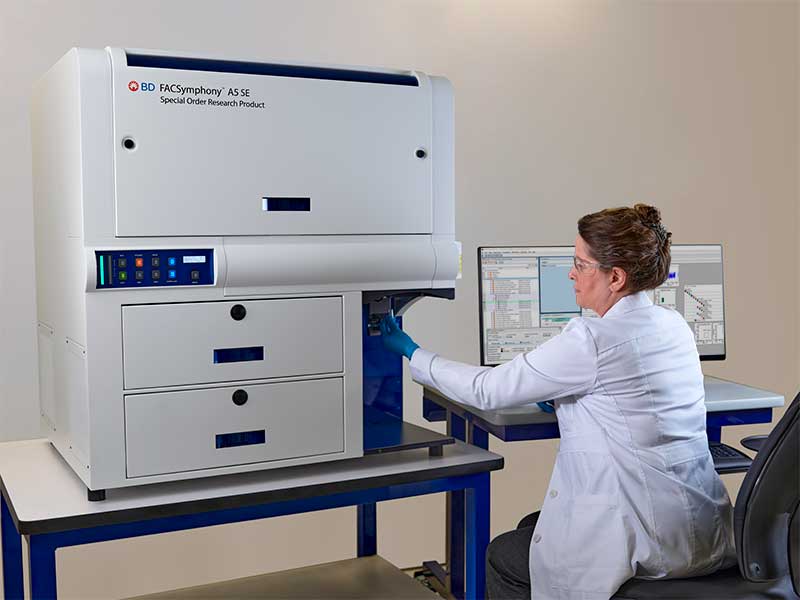-
Training
- Flow Cytometry Basic Training
-
Product-Based Training
- BD Accuri™ C6 Plus Cell Analyzer
- BD FACSAria™ Cell Sorter Cell Sorter
- BD FACSCanto™ Cell Analyzer
- BD FACSDiscover™ A8 Cell Analyzer
- BD FACSDiscover™ S8 Cell Sorter
- BD FACSDuet™ Sample Preparation System
- BD FACSLyric™ Cell Analyzer
- BD FACSMelody™ Cell Sorter
- BD FACSymphony™ Cell Analyzer
- BD LSRFortessa™ Cell Analyzer
- Advanced Training
Old Browser
This page has been recently translated and is available in French now.
Looks like you're visiting us from {countryName}.
Would you like to stay on the current location site or be switched to your location?
New BD Cell Analyzer Includes Spectral Analysis Capabilities
BD FACSymphony™ A5 SE (Spectral Enabled) Cell Analyzer offers users flexibility of using spectral or conventional flow cytometry analysis
September 13, 2021
BD Biosciences announces the launch of a spectral-enabled cell analyzer, expanding current cell analyzer capabilities to at least 34 parameters with live spectral unmixing, enabling researchers to precisely analyze selected single cells from complex samples.
The new BD FACSymphony™ A5 SE Cell Analyzer is a fluorescence-activated, spectral-enabled cell analyzer that offers researchers the ability to choose between spectral or compensation-based cell analysis to meet different flow cytometry needs. It is an important addition to the extended family of BD FACSymphony™ Cell Analyzers and Sorters, including the recently announced BD FACSymphony™ A1 Cell Analyzer, which offers premium performance in a benchtop format. For existing users of the BD FACSymphony™ A5 Cell Analyzer, software and hardware upgrades are available to enable spectral analysis.

“By enhancing our BD FACSymphony™ A5 instrument technology with spectral-enabling capabilities, we are responding to the expressed needs of our customers and laboratories, who want the flexibility to perform both conventional and spectral flow cytometry analyses on a single instrument,” said Puneet Sarin, worldwide president of BD Biosciences. “Offering an analyzer with both spectral unmixing and compensation-based cell analysis gives customers the ability to transition to spectral analysis as needed and as their users are ready.”
With spectral unmixing, researchers have access to expanded dye capabilities to build larger panels or ease panel design efforts. Compensation-based analysis supports labs with existing protocols and users not ready to fully move to spectral analysis.
Spectral flow cytometry represents an alternative data acquisition and analysis strategy to conventional flow cytometry, providing flexibility of fluorescent label inputs without having to change filters, as well as the ability to multiplex more fluorescent labels in one multicolor sample. Spectral unmixing is a procedure that calculates the amount of each fluorophore present on a cell based on the full emission profile of each individual fluorochrome.
For more information or to request a demo, visit our BD FACSymphony™ A5 SE Cell Analyzer page.
The participants were asked questions about their projects prior to the course, which was integrated into the training, according to Florian. Still in praise of Dr. Joerg Schlender and his experience, Max adds that it was very useful to put up questions related to personal projects during the class and get profound answers.
Timing and expectations
Max feels that the amount of information given every day and the general structure of the week was good, as were the proportion of theory and practice. “It was an awesome possibility to get a profound knowledge on performing multicolor experiments and on operating the LSRFortessa™”, he adds, feeling truly satisfied with the course.
On his part, Florian feels that everything in the course was well timed. “A little troubleshooting part would be a plus”, Florian adds as a recommendation for future courses.
Conclusions
Both Florian Weber and Max Heiduck are very positive about the BD LSRFortessa™ X20 and BD FACSCelesta™ operator course conducted by the BD European Training Centre. Flow cytometry experiments can be tricky, but not if one is armed with proper training provided by experts. This course is very much recommended for the users and will help them get the best out of their instruments.
For more information about the course and how to register, refer to the course flyer available at this link.
If you have any other questions, please contact BDB.Training@bd.com.